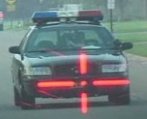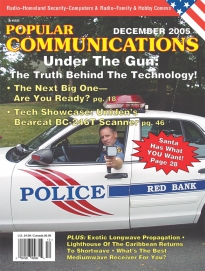


|
Article Review: Radar-Based Hazard Alerting And The Evolving Telematics Scene Popular Communications, December 2005 By Alan Dixon, N3HOE/WPUC720/KST8678  This article focuses on radar-based hazard alerting. After briefly describing the different police radar bands, it goes on to give a great technical overview of both SWS (Safety Warning System) and Cobra's SAS (Safety Alert System). The author also goes on to describe how it appears that SWS has completely failed in the marketplace, which appears to be true: the best evidence available tells us that not all states have SWS transmitters, and there are few states with more than a handfull of these at all. Which begs the question: Why would municipalities spend their money on equipment just to alert detector users of hazards in the first place?
This article focuses on radar-based hazard alerting. After briefly describing the different police radar bands, it goes on to give a great technical overview of both SWS (Safety Warning System) and Cobra's SAS (Safety Alert System). The author also goes on to describe how it appears that SWS has completely failed in the marketplace, which appears to be true: the best evidence available tells us that not all states have SWS transmitters, and there are few states with more than a handfull of these at all. Which begs the question: Why would municipalities spend their money on equipment just to alert detector users of hazards in the first place? The author dumped his SWS equipped detector for a detector with SAS (apparently a Cobra XRS-9700, it seems that Cobra has a patent on their SAS system). A news article from back in 1998 claimed that there were approximately 2000 SAS transmitters spread across all 50 states. If that is really true and hazard alerting is your primary concern, SAS might be the ticket, just as the author concluded. Although most hard-core enthusiasts completely ignore these features when selecting a radar detector (due to limited use etc), they DO serve a purpose beyond that of hazard alerting: they add somewhat of an appearence of legitimacy to radar detectors. In fact, a judge in Virginia once ruled that detectors equipped with SWS were not subject to Virginia's detector ban (I believe this was later overturned). I also know that some reading this might scoff at the idea of using an SAS-equipped Cobra radar detector. But if you like the features such as SAS, and you don't have a lead foot and only occasionally drift over the posted limits, then they might be your cup of tea. The article goes on to describe new threats facing the detector industry: POP and RDDs. The information is generally accurate, however we did find one discrepancy. The aticle states: "The radar transceiver (gun) must be absolutely stationary during the [POP] burst duty cycle, or if it were to be used in a moving configuration, the sustained speeds of both the transceiver and the target - even for mere milliseconds - would have to be clocked with laboratory-grade accuracy, factoring in any acceleration or deceleration, at least on the part of the transceiver station" However, in the operator's manual for our POP-enabled MPH Enforcer (a stripped down BEE III) it states that: POP mode works in all radar modes, stationary, opposite direction moving mode, and same direction moving mode. You really can't blame the author, this misinformation had been circulating on the web for a while. It is possible that early BEE/Enforcer units had to be stationary for POP use, but if that used to be the case, it isn't anymore. Also absent from the article is mention of 16ms MPH Z-Series POP, which IS stationary only. But, this information is not widely known either: I'm sure detector manufactuirers are reluctant to publish much information on it because most of them still can't detect it, although they seem to have the 67ms Ka version licked (67ms K has yet to be tested). Some have speculated that the longer burst in the BEE/Enforcer is to compensate for extra error margin in moving mode. Apparently Technisonic (manufacturer of the VG-2) was contacted in regards to the "VG-3" which many of us know is a fantasy of a certain scrambler manufacturer. However Technisonic also told Popular Communications that "there are no plans to design or manufacture any newer RDD". This raises some questions in light of the "VG-4" prototype tested at SML 2005. Did they scrap plans for the VG-4 since it tested poorly? Did they decide to give up on RDDs since there is a new detector coming out which reportedly will be able to defeat all present and future RDDs? Finally, the author suggests some tips on what to look for when buying a radar detectior. He appears to be disillusioned with published test results (sound familiar?) stating that: There are several websites, some well known, proffering product evaluations and consumer advice about radar detectors. Most are not worth the bandwidth they consume. He further states that "I would expect at least reporting of results according to standard statistical practices, particularly in regard to establishing statistical significance, from any testing entity billing itself as a 'laboratory'" He goes on to say "be wary of any such test reporting that makes overuse of superlatives and metaphors, and that overindulges in witty, sarcastic, or irrelevant remarks. And you've really got to wonder about the testing and technical evaluations produced by racecar drivers with no engineering background evident." Hmmmm, does the above sound vaguely familiar to anyone? Alan, the Guys of LIDAR hear you loud and clear. Our goal is that by the time you write your next radar detector article, you'll be able to say that at least one test source isn't just wasting bandwidth. jimbonzzz Guys of LIDAR |
||||||||||
HOME | Tests & Reviews | FAQ | Technical Info | Articles | Videos | Links
About GOL | Contact Us | Terms of Use | Site Map